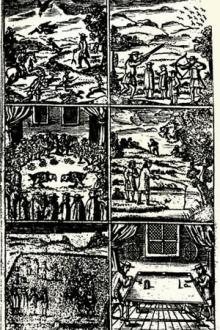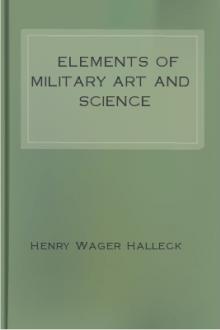The School of Recreation, Robert Howlett [general ebook reader .TXT] 📗

- Author: Robert Howlett
- Performer: -
Book online «The School of Recreation, Robert Howlett [general ebook reader .TXT] 📗». Author Robert Howlett
Your Hook must be long in the shank, something Round in compass, the point strait and even, and bending in the shank. Set on your Hook with strong small Silk, laying your Hair on the inside of the Hook.
Your Flote challenges divers ways of making. Some using Muscovy Duck quills for still Waters. Others the best sound Cork without flaws or holes, bored through with a hot Iron, and a Quill of a fit proportion put into it; then pared into a pyramidal Form, or in the fashion of a small Pear, to what bigness you please, and ground smooth with Grindstone or Pumice; this is best for strong Streams.
In fine, To plum the Ground, get a Carbine Bullet bored through, and in a strong twist hanged on your Hook or Rod. To sharpen your Hook, carry a little Whetstone. To carry your several utensils without incommoding your Tackle, have several Partitions of Parchment. And in short the ingenious Angler will not be unprovided of his Bob and Palmer; his Boxes of all sizes for his Hooks, Corks, Silk, Thread, Flies, Lead, &c. His Linning and Woollen Bait-bags; His splinted Osier light Pannier; and lastly his Landen Hook, with a Screw at the end to screw it into the socket of a Pole, and stricken into the Fish, to draw it to Land: To which socket, a Hook to cut up the Weeds, and another to pull out Wood, may be fastned.
Baits are branched into three Kinds.
First, the Life-baits, which are all kind of Worms, Redworm, Maggot, Dors, Frogs, Bobb, Brown-flies, Grasshoppers, Hornets, Wasps, Bees, Snails, small Roaches, Bleak, Gudgeon, or Loaches.
Secondly, Artificial living Baits, of Flies of all sorts and shapes, made about your Hooks with Silk and Feathers, at all times seasonable, especially in blustering Weather.
Lastly, dead Baits, Pasts of all makings, Wasps dryed or undryed, clotted Sheeps-blood, Cheese, Bramble-berries, Corn, Seed, Cherries, &c. The two first good in May, June and July, the two next, in April; and the last in the Fall of the Leaf.
Of Flies.
Of Natural flies there are innumerable, and therefore it cannot be expected I can particularize all; but some of their names I shall nominate, viz. The Dun-Fly, Red-fly, May-Fly; Tawny-Fly, Moor-Fly, Shell-Fly, Flag-Fly, Vine-Fly, Cloudy or Blackish-Fly, Canker-Flies, Bear-Flies, Caterpillars, and thousands more, differing according to the Soils, Rivers or Plants.
Artificial Flies, are made by the Ingenious Angler, according to Art, in shape, colour and proportion like the Natural Fly, of Fur, Wool, Silk, Feathers, &c. To delineate which I must confess my self not so accurate and skilful a Painter, nor can any Pen-drawing, illustrate their Various Colours so, as to direct their Artificial Counterfeit; Nature will help him in this by Observation, curiously Flourishing their several Orient and bright Colours, after which they take their names, as before said: And therefore to furnish your self with both Natural and Artificial Flies, repair in the Morning to the River, and with a Rod beat the Bushes that hang over the Water, and take your Choice.
1. Observe to Angle with the Artificial Fly in Rivers disturbed somewhat by Rain, or in a Cloudy day, the Wind blowing gently: If the Wind be not so high, but you may well guide your Tackle, in plain Deeps is to be found the best Fish, and best Sport: If small Wind breeze, in swift streams is best Angling: Be sure to keep your Fly in perpetual slow Motion; and observe that the Weather suit the Colour of your Fly, as the light Colour'd in a Clear day, the Darkish in a dark, &c. As likewise according to the Waters Complexions, have your Fly suitable.
2. Let your Line be twice as long as your Rod: Keep as far as you can from the Waterside, the Sun on your back; In casting your Fly, let that fall first; your Line not touching the Water.
3. Have a nimble Eye, and active quick Hand to strike presently upon the rising of the Fish, lest finding his mistake he spew out the Hook.
4. In slow Rivers cast your Fly cross them, let it sink a little, draw it back gently, without breaking or circling the Water; let the Fly float with the Current, and you will not fail of excellent Sport.
5. Observe to let the Wings of your Salmon-Flies to be one behind another, whether two or four, and they and the Tail long, and of the finest gaudiest Colours you can choose.
Lastly, In clear Rivers a small Fly with slender Wings is best, and in muddied Rivers a Fly of a more than ordinary large Body.
Thus much for Flies, I come next to that I called Dead-Baits, and shall begin with the several Ways of making Pastes.
Of Pastes.
1. Beat in a Mortar the Leg of a Young Coney (Vulgarly called the Almond) or of a Whelp or Catling, and a quantity of Virgins Wax and Sheeps suet, till they are incorporated, and temper them with clarified Honey into Paste.
2. Sheeps-Blood, Cheese, fine Manchet and clarified Honey tempered as before.
3. Sheeps-Kidney-suit, Cheese, fine Flower, with clarified Honey tempered.
4. Cherries, Sheeps-Blood, Saffron and fine Manchet made into a Paste.
5. Beat into a Paste; the fattest Old Cheese, the strongest Rennet can be got, fine Wheat-flower and Annis-seed Water: If for a Chub you make the Paste, put a little rasty Bacon,
Lastly, Mutton-Kidney-suit, and Turmerick reduced to a fine Powder, the fattest Old Cheese and strongest Rennet, wrought to a Paste, adding Turmerick till the Paste be of a curious Yellow; and is excellent for Chevin.
Anoint your Bait with this Confection: Take the Oyl of Aspray, Coculus India, and Assa-fœtida beaten, and mix with it as much Life-Honey; then dissolve them in the Oyl of Polypody, and keep it in a close Glass for your use. And that your Paste may not wash off your Hook, beat Cotten-Wool or Flax into it.
Of keeping Baits.
The Red-Worm, must be kept in a bag of Red Cloth, with a handful of chopt Fennel, mixt with half so much fresh, black and fertile Mould will scoure and preserve them: All other Worms, with the Leaves of Trees they are bred on, renewing them often in a day. Only the Cad-bait, Bob and Canker, &c. must be kept in the same things you find them.
The great White Maggots, keep them in Sheeps Tallow, or little bits of a beasts Liver; and to scour them, hang them warm in a bag of Blanketing with Sand.
The Frogs and Grasshoppers, in wet Moss and long Grass, frequently moistned; and when used, the Legs of the first, and the Wings of the other must be cut close off.
The Flies, use them as you take them. Only, the Wasps, Hornets and Humble-Bee, must be dryed in an Oven, their heads dipt in Sheeps blood, and dryed again, may be kept in a Box for use.
And now thus equipt let us walk to the Rivers side.
To begin then with the Barbel. The best time for Angling for this Fish is at the latter end of May, June, July, and beginning of August, in his Haunts aforementioned; and the best Bait (omitting others) is the well scoured Lob-worm (being of a curious cleanly Palate as well as shape) or Cheese steept an hour or two in clarified Honey. He is a subtile Fish, extraordinary strong, and dogged to be dealt with, and therefore be sure to have your Rod and Line strong and long, or you may endanger to break it.
For the Breame. The most seasonable time to Angle is from St. James tide till Bartholomew tide. He spawneth in June or beginning of July; is easily taken, as falling on his side after one or two gentle turns, and so drawn easily to Land. The best Bait for him (most delightful to him) is the Red-Worm (found in Commons and Chalky Grounds after Rain) at the root of a great Dock, wrapt up in a round Clue. He loves also Paste, Flag-Worms, Wasps, Green-Flies, Butter-Flies and a Grass-hopper, without Legs.
Bait your Ground the Night before with gross-ground Malt, boiled and strained, and then in the morning with the Red-Worm, bait your Hook, and plumbing your Ground within half an Inch, Fish.
The Bleak, an eager Fish, is caught with all sorts of Worms bred on Trees or Herbs, also with Flies, Cad-bait, Bobs, Paste, Sheeps-Blood, White Snails, Wasps, Gnats, &c. In a warm clear day the small Fly at the rim of the Water is best; in a Cloudy day, Gentles or Cad-baits two foot in the Water.
The Bull-head or Millers-Thumb, being Childrens recreation, I shall speak little of them, only being serviceable for Baits, I shall only say he is easily taken with a small Worm, being lazy and simple, and will swallow any thing; and the Minnow, Loach, and Bansticle being of the same diet, I place here too.
The Chevin, loveth all sorts of Worms, Flies, Cheese, Grain, and Black Worms, their Bellies being slit, that the White may be seen: And very much delighteth in the Pith of an Oxes back, the tough outward skin being carefully taken off, without breaking the inward tender skin. In the Morning early angle for Chevins, with a Snail; in the heat of the day, with some other Bait; in the afternoon with the Fly; the great Moth, with a great Head, yellow Body, and whitish Wings, usually found in Gardens, about the Evening: The larger the Chevin, the sooner taken; loving his Bait larger, and variety on a Hook.
The Char is a Lancashire Fish, found in a Mere, called Winander-Mere in that Country, the largest in England.
For the Chub, called by some a Chevin, by others a Villain. Bait your Hook with a Grass-hopper, find the hole where he lies, accompanied in a hot-day, with twenty or more, floating almost on the very superficies of the Water; choose which you think best, and fairest, and drop your Hook some two foot before him, and he will bite at it greedily, and cannot break hold with his Leather Mouth; let him play and tire, lest you break your Line. If you cannot get a Grass-hopper, then any Worm, or Fly you will. In cold Weather, Fish for him near the bottom, and the Humble-Bee is the best Bait. Some appropriate Baits according to the Month, but I shall Omit that; The Chub (being best and in his Prime in the Winter) a Paste made of Cheese, and Turpentine, is the only Bait to take him.
The Carp is subtle, and full of Policy, will never bite in Cold Weather, but in Hot you cannot be too Early, or too Late. In March, he seldom refuseth the Red-worm, in June the Cad bait and the three next Months the Grass-hopper: Pastes that are sweet, of which I have spoken before, are very delightful to Carps: And especially, if you Bait your ground two or three dayes before you angle, with Pellets of course Paste, Chickens-guts, Garbage, &c. Gentles anointed, and a Piece of Scarlet dipt in Honey, put them on the Hook, is an approved way.
The Dace, Dare, Rudd, and Roach, being much of a kind, and feeding, I shall put together, and are easily taken with small Worms, Bobs, Cad-baits, Flies, Sheeps-Blood, all sorts of Worms bred on Trees or Herbs, Paste, Wasps, Gnats, Lipberries, &c. The Heads of the Wasps,





Comments (0)